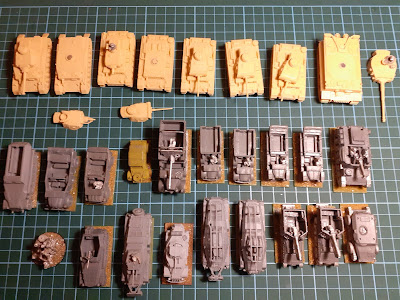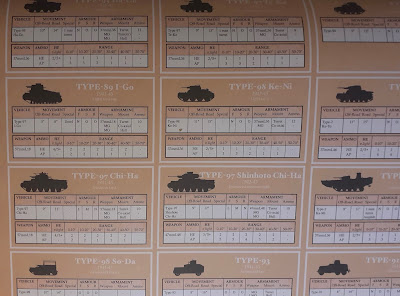Greetings all,
I’m sorry I haven’t been very active recently, a combination of blogger being hard to use on an iPad and the usual lack of functionality has drained my productivity. I have achieved some bits and bobs though, including helping my wife expand and diversify her business.
You may have read my previous posts about how much I love the Napoleonic Naval Warfare rules Post Captain by Old Dominion Game Works and how I was interested in getting into WWII Naval warfare with ODGW’s General Quarters 3 rules but had struggled due to the bad customer services and weird policies of the one company that sell hard copies in the U.K.
Because of this ODGW’s excellent stable of rules doesn’t get the exposure and table time they deserve in the UK and my wife and I decided we could try and change this. So whilst I’m not capable of actual work (years of hard, manual labour lugging timber and climbing trees are sadly behind me now and I miss them terribly) I could advise my wife on what I thought of their products and that there should be a market for them. A week or two of overexcited waiting by the window and our first order arrived. We couldn’t get everything but we did try and order a good range of the most popular rulesets to get us started. So here is a brief overview of what she currently has to offer (if you click on the hyperlinked product name it will take you to the eBay listing):
Post Captain is a set of Naval war game rules suitable for the Napoleonic era (1793 to 1815 the carronade era specifically) covering ship to ship actions up to whole fleets, from luggers, ketches and brigantines up to mighty first rates including merchants of all sizes. It is suitable for all scales including the recent Warlord games Black Seas 1/700 ships and additional scaled measuring devices are available as downloads when you register your copy (along with a comprehensive selection of bonus material, ships and scenarios). The included ship logs cover the fleets of the main combatants for the period and additional rules cover land warfare, weather, cutting out, weapon types including swivel guns, canon and carronades and an excellent introduction to how sailing works and how the rules model this on the tabletop. I can’t recommend these rules enough, whilst I may change scales and move to the smaller 1:1200 scale offered by Rod Langton miniatures, they will be my ongoing set of age of sail naval rules and I have many plans for what I’d like to do with them.
General Quarters 3 is ODGW’s set of rules for surface, air and submarine warfare during WWII. As the third edition of these rules it has been totally rewritten and the best description of my first opinion when I opened my copy is comprehensive yet approachable. The rules cover everything from Destroyers to Battleships and carriers, torpedoes, air warfare, submarines, mine warfare, weather, campaign games and much more. They work for a range of scales (depending on what you already have or like and how much space you have available) and there are a number of different measuring scale options to further adapt the rules to your set-up (1cm 100yds or 1cm to 200yds). Optional rules include simplified or rather streamlined versions of the torpedo system, submarine warfare and how aircrafts are handled allow you to tailor the game to your preferences. Gunfire (and many other features) are resolved using the nation specific CRT charts which, whilst initially looking complex and daunting, make combat resolution very easy and reduce the need to refer to the rulebook and clutter the table during play. Included are hundreds of ships logs for the most common combatants and further digital deluxe ship log collections are available seperately (although if you understand the very straightforward ship log system and know what ship you wanted to model you could produce them yourselves with a little effort). I'm very excited about these rules and whilst I've run though the basics using counters I'm about to bite the bullet and order some Navwar 1:3000 destroyers and cruisers to see if they appeal to me and I can get them table top ready for when I can get back out into the world and introduce it to my local club.
The campaign system for GQ3 is very flexible and easily allows you to create your own detailed campaigns. A number of prewritten campaigns are available which use a unique decision tree system to generate the tactical engagements (and need no plotting) whilst allowing replays to avoid becoming predictable and boring for the players. Each campaign in the ODGW Decisions at Sea series contain detailed background history and full OOB's necessary to get the conflicts to the tabletop and are further supported by online access to extensive digital downloads on the ODGW website and forum.
Sudden Storm is a fictional 'What-if' campaign set in 1937 recreating a worldwide hot conflict between Japan and the USA. With a excellent and thorough background section to set the scene this book allows players to enter a period of naval warfare that was only fleeting in the real WWII. There is no radar, electric torpedoes, PT Boats, 24" Type 93 "Long Lance" [Sic] torpedoes, US magnetic torpedo exploder problems, decks filled with AA guns or VT Fuses, long range airplanes, heavy bombs, drop tanks or self sealing fuel tanks. Battle lines and big guns still rule. Comprehensive OOB's for both sides, specific ship logs and aircraft makes this fictional period come to life.
There is also Defending the Malay Barrier in the series following the disastrous Allied ABDA defence of the Malay Barrier but unfortunately we don't currently have this to offer as ODGW did not have any stock. We will be stocking this in the future though.
Fleet Action Imminent is the General Quarters WWI ruleset for Naval combat during the Great War. The rules contain everything you need for WW1 Naval Wargaming with rewritten and streamlined surface combat rules specifically for the Great War with Special Fleet Action rules for large battles with lots of Destroyers. Inside you'll find National tables for Gunnery, Damage, Detection and Morale, a streamlined torpedo system for faster and easier resolution, new ship and airship turn indicators and additional rules for Coal Smoke, Minefields, Night Actions, Signals, Shore Batteries, Airships, Blimps and much more. More than 500 WWI Colour Ship Logs and additional Airship Logs are included along with additional material available to download when you register. I don't yet have these rules but will probably buy myself a copy soon as it looks like a really interesting period.
The North Sea Campaign covers the critical fight for control of the North Sea and uses the same mapless plotting and decision tree system seen in the GQ3 campaign books. It also includes full OOB's for the conflict and access to full colour downloadable ship logs from the website.
Mein Panzer is a core rule book which are flexible and expandable 1:1 (one model represents one vehicle or soldier) rules for recreating 20th and 21st century combined arms ground warfare from World War One up through to the present day. Designed to be used with scales from 1/285 (6mm) to 15mm, based around ODGW's Drop-In game system allowing players from novice to veteran to customise the gameplay to their own particular gaming style. Once you've learned the core rules you can Drop-In additional modules to fit your chosen theatre and period of combat. The core rules are divided into three sections. The first section contains the basic rules dealing only with Tank vs Tank battles to quickly teach the principles of the game. The second section contains the advanced rules which build upon the basics to form the cornerstone of the rule system. The last section includes a number of Drop-In modules, each dealing with specific areas of ground combat covering such areas as Morale, Command and Control, Infantry, Air Support, Artillery, Armoured Trains, Amphibious assaults, Structures and Engineers. Included is a generous selection of starter data so you can start playing as soon as possible. Including equipment tables, TO&E, aircraft, small arms and basic troops for WW1, WW2, The Cold War and the ultramodern period.
Mein Panzer WWII Data Book contains over 7,300 data entries for 29 Nationalities including several thousand pieces of equipment, TO&E, ordnance tables, naval support equipment, small arms, troop types and special rules for the conflict. From the Japanese Knee Mortar to the German King Tiger. Each country has an included Troop Table detailing five quality levels, plus numerous special troops. Everything from the Afrika Korps to Cossacks and the SS. It also includes the special rules needed to play in every theatre of conflict with virtually any combatant. The Mein Panzer rule book is needed to fully utilise the contents of this book but the TO&E and equipment information would be usable for any WW2 wargame with very little adjustment.
Other data books are available including WWI, The Spanish Civil War and The Korean War and whilst we don't currently have stock of these we intend to in the future. Whilst I don't yet own MP it is also on my wish list as I love WWII gaming (maybe my favourite period) and always welcome new, decent rulesets to allow me to play games that have a real sense of WWII (It's a game so realism is never really possible or the aim but the feel is important).
PLEASE NOTE ALL THESE RULES ARE LOOSE LEAF 3 HOLE US PUNCH ONLY AND IN THE UK YOU WILL NEED TO PURCHASE A BINDER AND POLY POCKETS TO STORE THESE RULES.
If there are any other ODGW products you are interested in please contact us through the eBay site and we can order them for you for a small deposit. Any questions about the products please get in touch as we want to help promote these excellent rules (and ODGW) and as fellow gamers we care about what we are selling and helping people get to enjoy them.
Thank you for taking your time to visit, I hope we can help you play some of these excellent rules and inspire you to getting them to the tabletop. I'll get back to actual blogging soon and try and show some progress as I now have access to a computer which makes Blogger usable again.
Stay safe, look after yourself and others,
BALM





















































